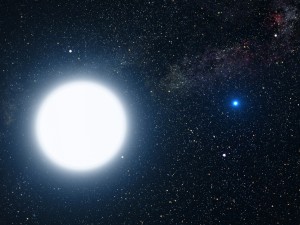Despite the tremendous advances that the scientific community makes every year, there are still common misconceptions that, for whatever reason, have survived though they have no basis in fact. In an effort to set the record straight, let’s take a look at ten of the most common science myths and do a little busting (myth-busting that is).
10. Evolutionary Improvements

It is a commonly held misconception that evolution is the process of an organism or species to progress from ‘lower’ to ‘higher’. While scientists can point to concrete examples of evolution and natural selection hard at work, there are also numerous examples of instances where the inverse is true. Ideally, the natural progression of evolution means that only the best traits of a species are passed on through successive generations but let’s take a look at a couple of scenarios where that has not been the case.
Look at sharks, crayfish, and many types of fungi. There is evidence that these organisms have remained largely unchanged for hundreds of thousands of years, millennia in some cases. These organisms were so well suited for their habitats that there has simply been no need for a change—for a long, long time. In these cases, evolutionary changes could actually decrease the suitability of some of these organisms for their environment meaning that evolution in this instance would be devastating for the longevity of the species.
9. Humans Pop in Space

Space is a nasty place for just about everything but rocks and dust. Somewhere along the line people got it into their heads that if a person goes out into the vacuum of space they will pop from the inside out like a marshmallow in a microwave.
While this myth may be an excuse to add some gory special effects to science fiction films, the reality is that a person can, in fact, survive in space for up to 30 seconds as long as they have exhaled before exposure. If they have inhaled, their lungs can burst or collapse and cause an influx of air into a person’s bloodstream. Either way, after 30 seconds or so, an unprotected person in space will pass out and die from a lack of oxygen.
8. Brightest Star

For as long as we have explored the globe we have relied on the stars for navigation. The most famous of the navigational stars is Polaris or the North Star. It is a common, and false, held belief that Polaris is the brightest star in the northern hemisphere’s night sky. This is understandable, considering the fact that many explorers have relied on it and there have been countless people who have found their way through stellar navigation.
In fact, it is the star Sirius that is brightest in the Northern hemisphere’s night sky with a magnitude of 1.47. The lower a star’s magnitude, the brighter it is and Sirius wins out over Polaris’ magnitude of 1.97.
7. The Five Second Rule

The five-second rule is a product of two things; pseudo-science and the desire of people to reclaim food that would otherwise be lost when it falls on the floor. For those who may not be familiar, the five-second rule states that food that is dropped on the floor will be safe to eat, or relatively bacteria and germ-free, if retrieved within five seconds.
The five-second rule has absolutely no basis in fact. There is no grace period where food will be impervious to bacteria—if food falls on the floor it will immediately pick up any germs it comes into contact with. There is some variance with the consistency of the food in question. Wet foods will pick up more germs than dry ones, but there is no such thing as a five-second rule.
Of course, while eating food off of the floor may be disgusting, it is often not actually dangerous or unsafe; just save it for when you’re alone or with friends. Diners at a restaurant may frown on you eating straight from the floor.
6. Dark Side of the Moon

Contrary to the title of the Pink Floyd album, there is, in fact, no such thing as a dark side of the moon.
In reality, there is no part of the moon that is not illuminated by the sun at some point. While it is true that there is a side of the moon can never be seen from the Earth that does not mean that it is never struck by rays of light from the sun. This is due to a circumstance known as tidal locking. The gravitational pull that the Earth exhibits on the Moon is so strong that the Moon stays immobile in orbit. While it circles the earth, it does not spin on its own axis.
5. Brain Cells

You may have heard that you should be careful racking up a massive bar tab; not only does money not grow on trees, but your brain cells can’t regenerate. Once they are gone they are gone and your brain will not regenerate any new ones to replace the lost cells.
This is such a prolific misconception because the scientific community wholeheartedly believed it for some time. In 1998 however, scientists discovered that brain cells in adults can in fact regenerate. Researchers are still working out exactly how to leverage this information for the benefit of the healthcare community, but when the inevitable breakthrough occurs there is hope for the combating of previously untreatable degenerative cerebral diseases.
4. Pennies from Heaven
You may have heard that even a small object if dropped from a significant enough height, can accelerate to speeds that can be lethal for people below. This is evidenced in the popular urban legend that a penny dropped from a very high building (such as the Empire State Building) can kill a pedestrian on the sidewalk below.
The reality is that the flat sides of a penny give it such air resistance that it cannot achieve lethal speeds. There is simply not enough of an aerodynamic profile for a penny to kill, though it will probably leave a hell of a bruise. While it would be exceedingly difficult to try an ultra-high penny drop in a vacuum, the lack of air resistance would allow the penny to reach terminal velocity, perhaps fast enough to kill.
3. Friction Heat

It is common knowledge that many of the objects from outer space that strike the Earth burn up on entry to the atmosphere. The myth is that this heating occurs from the friction of the meteor (or piece of a satellite, etc.) is caused by the friction of the air passing over the rapidly accelerating object.
This isn’t entirely true. While the heating has to do with the air, it isn’t friction that causes the rise in temperature. When the object is speeding toward the ground, locked in Earth’s gravitational pull it is actually rapidly compressing the air in its path. This compression causes the material to heat up and glow, a glow that can be seen if you happen to be looking in the right sector of the night sky. We know them as shooting stars.
2. Lightning

You may have heard that lightning never strikes the same place twice. This isn’t true, seeing as there are many places that are frequently struck by lightning.
Lightning is a function of the release of a charge buildup in both the ground and a charged cloud. Electricity opts to take the path of least resistance so therefore the tallest landmarks are more prone to strikes. Skyscrapers are frequently struck, sometimes as often as 20 or 30 times a year.
Remember that fact next time you’re caught outside with a storm on the horizon. Stay away from open fields or parking lots; you don’t want the tallest thing around to be you!
1. Gravity in Space

It is a common myth that there is no gravity in space. This is understandable, considering all of the footage we see of floating astronauts swimming through their spaceships and walking on the ceilings.
The truth is that they are still being pulled toward Earth by the planet’s gravitational pull. They are at the orbital ‘sweet spot’ however, a distance that means that they are still falling ‘downwards’ but are at the right distance that they are always falling tangent to the planet and therefore will remain floating. It is for this same reason that satellites don’t come crashing back to the surface and that the moon doesn’t collide with the Earth.
